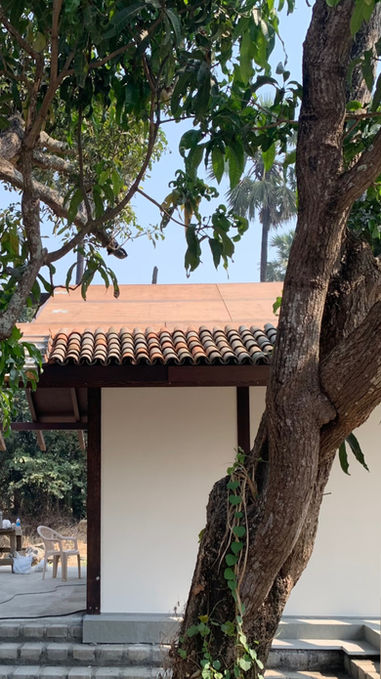The House at Awas
Residential Architecture I Alibag, Maharashtra
Client Sunita Namjoshi
Area Main house- 4000 sq.ft, Skill center - 3500 sq.ft
Status Ongoing
Team Shimul Javeri Kadri, Sarika Shetty, Ahanta G, Tushara M, Nilay Shah
The ethos of this project involved legacy, conservation, warmth, simple-engineering and fuss-free living.
In a world full of green-washing, how do you tread gently, in a coastal town with predominantly black cotton soil to avoid concrete mammoths being flumped onto the ground? On a site where 2 trees embrace each other and teach us to grow in harmony, how do you build not only ‘around’ but also ‘with’ the unspoken protagonists of the site?
This was our response to the brief for a retirement home and skill center in Awas, Alibag, for one of our patrons of design, who we have had the pleasure of working with on 13 projects so far.
The ethos of this project involved legacy, conservation, warmth, simple-engineering and fuss-free living. The brief was to create a compact house that drew inspiration from old Alibag houses and entailed minimal maintenance.
Following the footsteps of the wadas of Maharashtra that exhibited exuberant timber framework detailing, we explored timber as our structural system.
A timber home amidst the trees
Canadian wood had a single entity managing imports, connecting designers to contractors and also providing structural assistance. Certified sustainably managed forests ensured that whatever was being consumed, was also being given back to mother earth. These mainly involved species like Douglas fir & spruce-pine-fir.
We partnered with BuildKraft India, a Delhi based bespoke millwork and contracting team affiliated with Canadian wood, who guided us with our structural grid of 1.5 metres, spanning column free spaces upto 6 metres of depth, vetted by our structural engineer. The timber adopted was Doughlas-fir for the structural system and Yellow Cedar for the doors and windows.


Softwoods are less dense but grow at a much faster rate, making them a renewable resource when sourced from certified sustainably managed forests.

Softwoods as structural systems
Planks of softwood imported from Canada and transported by sea were trimmed and glued together under pressure at the BuildKraft India factory.
While traditionally local hardwoods were used in India that were more durable, their slow growth rate makes them less renewable and more expensive. Softwoods on the other hand are less dense but grow at a much faster rate, making them a renewable resource when sourced from certified sustainably managed forests. Coupled with technologies such as glue lamination leading to exceptional strengths and higher fire-resistance, softwoods make for better suitors for structural systems in the current times.
Assembly of a kit-of-parts
Various junctions and joineries between the timber members as well as the timber-to-RCC members were carefully detailed out. A visit to their studio at Delhi to review a 1:1 scale mockup of the same marked the first glimpse of our vision on paper to reality, a truly wondrous moment. These Glue Laminated Timber; ‘GLT’ sections were transported to site and assembled as a kit-of-parts by a team of skilled carpenters, who ensured every timber member sat snugly into the other, crafting each space at a time. A hybrid structural system was adopted with RCC upto the plinth to combat the sludgy black cotton soil, upon which 25% of the structure that comprised the first floor with a terrace embraced R.C.C, while the remaining 75% took up the timber post and beam structure.


This was a start in using timber in a residential project along with a dry walling technology.were chosen.

Dry walling systems
In keeping with the narrow timber sections, we were looking for a lighter walling material that could remain exposed. Thus a dry walling system was adopted, where cementitious boards are mounted on a framework of PPGI studs to form a lightweight yet sturdy composite wall. This is a common and popular system in more industrialized countries.
Sustainable timber with its contemporary technologies of glue and cross lamination are being seen as a highly sustainable future in lieu of concrete and steel. In Europe, multi-storey buildings are being constructed using this material. For us, this was a start in using timber in a residential project along with a dry walling technology.













